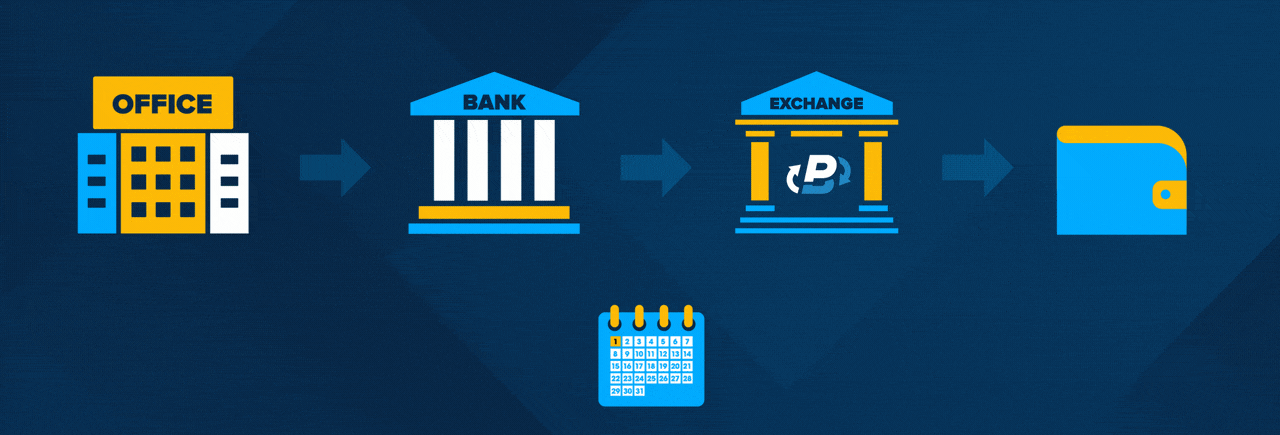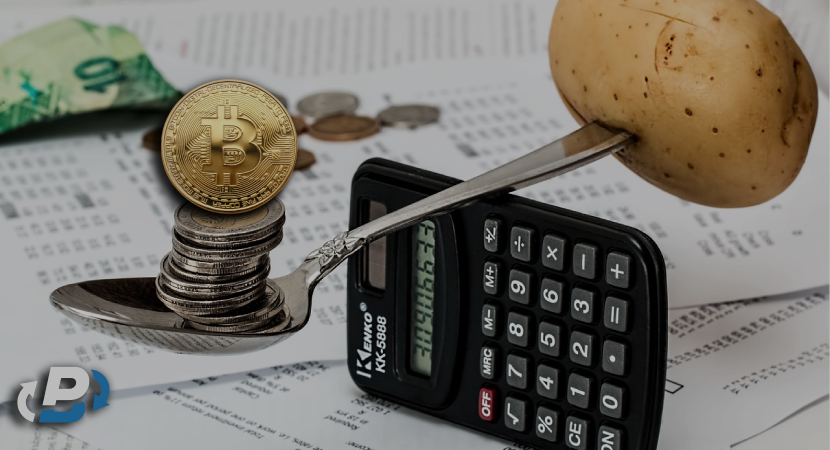In Inflation is on the rise, but so is the crypto sector, so it's no wonder that everyone’s asking how to protect my funds from inflation using Bitcoin? In a nutshell, the way to do so is to purchase a consistent amount of Bitcoin at regular intervals, such as once a month, a method known as Dollar Cost Averaging (DCA). Bitcoin's deflationary nature, with a fixed supply of 21 million coins, ensures that your investment maintains its value, unlike fiat currency, which can depreciate as governments continue to print money. DCA basically smooths out the price of whatever crypto you're buying over time (hence the name "dollar-cost averaging"). It’s a simple, hands-off way to invest that helps reduce the effects of market ups and downs. That’s why both newbies and seasoned investors use it—it just works. This simply explains the process: you get paid, transfer a certain amount of your salary from your bank to the Exchange, the same amount every month, and buy Bitcoin for your wallet and HODL it.

However, successful investment goes beyond merely buying the same amount of Bitcoin each month for example, it requires thorough strategic planning and careful, informed decisions. Consider this guide your compass and use it to navigate through the storm of inflation. We will walk you through all the essential financial principles at work, show you how to choose a reputable exchange and help you choose effective investment strategies.
Understanding Inflation & Its Effects
In the battle against rising prices, knowledge is your greatest weapon. To effectively shield yourself from inflation, you must first understand its nature.
What is Inflation?
The common misconception is that inflation simply means more money is being printed. As with most things in life, the truth is far more nuanced than that. Inflation is the rate at which the general level of prices for goods and services rises, resulting in a decrease in purchasing power. It's measured by a combination of the Consumer Price Index (CPI) and the Producer Price Index (PPI). Inflation can erode the value of money, meaning that over time, a unit of currency buys fewer goods and services. This impacts everything from daily living costs to long-term savings. At its core, inflation refers to the rate at which the general level of prices for goods and services rises, leading to a decrease in the purchasing power of money. Imagine you could buy a gallon of milk for $3 last year, but this year it costs $3.09. This 3% increase in price reflects the rate of inflation.
Causes of Inflation
Several factors can trigger different types of inflation:
- Demand-Pull Inflation
This occurs when the demand for goods and services exceeds their supply. Increased consumer spending, often driven by lower interest rates or government spending, can lead to demand-pull inflation.
The inflationary period we recently experienced was partially triggered by a demand pull. The demand increased when millions of Americans received stimulus packages during the COVID lockdowns, creating an unexpected buying surge. This, in turn, decreased the supply of goods, driving their prices upward. - Cost-Push Inflation
This happens when the costs of production increase, leading producers to raise prices to maintain profit margins. Common causes include rising wages, higher raw material costs, and supply chain disruptions. For example, when OPEC countries decide to cap oil production, they directly decrease its supply. As a result, market prices rise even though demand has not increased. - Built-In Inflation
Often referred to as wage-price inflation, it occurs when workers demand higher wages to keep up with rising living costs. Businesses then pass these increased labor costs onto consumers through higher prices. This creates a cycle where wages and prices continuously push each other up.
Of course, it’s possible to increase wages without causing built-in inflation. But that’s only possible when wages are raised at a rate that matches a rising rate of productivity. Unfortunately, politics and social sentiments drive wage increases much more often than common sense, making built-in inflation quite unpredictable. - Monetary Policy Failure
Central banks control the money supply through monetary policy. When central banks print more money, the increased money supply can lead to inflation if it outpaces economic growth. Historically, excessive money printing has led to hyperinflation, as seen in Zimbabwe in the late 2000s and Venezuela in recent years.
As demonstrated by the case of Venezuela, monetary policy can boost inflation to over 500%. At one point, the cost of a cup of coffee reached 1,000,000 bolivars (Venezuelan dollars). - Exchange Rate Jumps
Fluctuations in exchange rates can impact inflation. If a country's currency depreciates, the cost of imported goods rises, contributing to inflation. For example, a weaker dollar makes imports more expensive for the U.S., which can drive up prices for goods and services dependent on foreign inputs.
That said, some countries are much better protected against exchange rate jumps. Larger economies like the U.S. or the EU are less likely to experience dramatic changes.
How to use Bitcoin Hedge Against Inflation
Before evaluating which financial instruments to use, you should develop a strong understanding of best practices that apply to all inflation hedges. We cannot stress this enough – fundamental financial principles remain vital, no matter which hedge you choose. Here are key principles to keep in mind:
● Diversification
The age-old adage "don't put all your eggs in one basket" is still true. The importance of spreading investments across various asset classes cannot be overstated. This reduces risk by ensuring that if one investment performs poorly, others can compensate. Diversify across at least three types of assets to create a balanced portfolio.
● Regular Reassessment
It’s vital to regularly reassess your portfolio to adapt to changing market conditions. Economic shifts, interest rate changes, and geopolitical events can all impact both inflation rates and your investments. Periodic reviews allow you to adjust your strategy, rebalance asset allocation, and generally stay aligned with your financial goals.
● Staying Liquid
Maintaining a pool of funds that are ready to be moved ensures you won’t miss out on unexpected market opportunities. Liquid assets, such as cash, crypto, and marketable securities, provide that flexibility. Simply speaking, you should avoid overcommitting to illiquid investments that tie up your capital.
● Balancing Short-Term and Long-Term Investments
Balancing short-term and long-term investments helps manage risk and returns over time. Short-term investments, like savings accounts or short-term bonds, offer stability and easy access to funds. Long-term investments, such as stocks or real estate, have the potential for higher returns but come with greater risk.
● Stay Informed
Staying informed about economic trends, market conditions, and financial news helps you make educated decisions. That doesn’t mean you have to regularly read financial reports, attend seminars, and consult with financial advisors. But you should definitely try to keep up with major current events and analysis of how they will impact the economy.
● Cost Management
Pay attention to the costs associated with your investments. High fees and expenses can erode returns. Look for low-cost investment options and be mindful of transaction fees, management fees, and other associated costs. In the case of Bitcoin, you should also keep track of transaction fee fluctuations, as these rates can vary widely depending on the state of the cryptocurrency market.
● Sticking to Goals
Define your financial goals clearly. Understanding your objectives helps you choose appropriate hedging strategies and measure your progress. Whether you aim for capital preservation, income generation, or growth, having clear goals provides direction for your investment decisions.
Traditional Inflation Hedges
When it comes to protecting against inflation, there's no magic bullet. Investors have various strategies and assets at their disposal, each with its own advantages and drawbacks. It’s crucial to understand all your options and how they fit into your financial strategy.
Historically, investors have turned to several traditional assets to protect their wealth from inflation:
- Gold: Being humanity’s oldest inflation hedge, gold has been used for centuries to preserve wealth. Its widely accepted intrinsic value makes it a go-to Bitcoin hedge against inflation. The value of gold can fluctuate but it has historically risen during times of inflation.
Even though new gold continues to be mined every day, the metal is still technically considered to have a limited supply. That’s because the element can only be produced as a result of stars colliding, so the energy required to produce a single atom of gold is enough to vaporize the entire planet. - Real Estate: Real estate investments, especially rental properties, can provide steady income that adjusts with rising prices. Property ownership can act as a hedge against inflation because real estate values and rents often increase at times of recession. As inflation rises and wages fall due to a recession, a chunk of the population will look to downsize into low-priced housing. As a result, the demand for low-cost real estate shoots through the roof.
- Treasury Inflation-Protected Securities (TIPS): Issued by the U.S. government, TIPS are designed specifically to protect investors from inflation. The principal value of TIPS increases with inflation, as measured by the Consumer Price Index (CPI), ensuring that the purchasing power of the investment is preserved. Typically, investors receive their TIPS interest payments twice a year.
This may seem like an ideal financial instrument to protect against inflation, but that’s not true unless you’re willing to keep 100% of your assets in TIPS. The idea of hedging is to safeguard your funds while providing an opportunity for growth. But all you get with TIPS is an interest rate of 1-2%. - Commodities: Investing in commodities like oil, agricultural products, and metals can provide a hedge against inflation. This may seem counterintuitive, but it makes perfect sense. As prices for basic goods rise due to inflation, the value of these commodities increases in lockstep.
- Stocks: While not all stocks are immune to inflation, certain sectors such as utilities, consumer staples, and energy can perform well during inflationary periods. Companies with strong pricing power and the ability to pass on costs to consumers can maintain profitability even as costs rise.

Why Bitcoin?
Bitcoin offers a hedge against inflation, often outperforming traditional hedges. Not all of these features are unique, but you’d be hard pressed to find another financial instrument that can claim them all:
- Fixed Supply
Unlike fiat currencies, which can be printed in unlimited quantities by central banks, Bitcoin has a fixed supply. This scarcity makes it resistant to inflationary pressures. Currently, there are about 19,768,500 BTC in circulation. There will never be more than 21,000,000. - Decentralization
Bitcoin operates on a decentralized network, free from control by any single corporation or government, protecting it from inflationary fiscal policies that can devalue fiat currencies. Even though BTC is still vulnerable to major economic events, its price cannot be driven by a single central entity. - Unmatched Potential
Bitcoin has been prone to dramatic price increases since its inception. In 2013, Bitcoin’s price surged from $13 in January to over $1,100 in December. Similarly, during the 2017 bull run, Bitcoin's price skyrocketed from $1,000 to nearly $20,000. Most recently, in the wake of the COVID-19 pandemic, Bitcoin's price surged from around $7,000 in March 2020 to over $60,000 by April 2021 as investors sought safe havens amid economic uncertainty. - Portability
Bitcoin is easily transportable and can be stored digitally, making it more versatile than physical assets like real estate. Even when it comes to gold, portability can be a major issue. If you want to use gold to hedge inflation, you need a safe way to purchase, transport, and store it. Each of these steps entails considerable costs and risks. - Liquidity
Bitcoin can be quickly and easily converted to cash or other assets, offering more immediate liquidity compared to real estate and even gold. Even if you keep your BTC on a hardware wallet, you’re still able to cash it in fairly quickly, regardless of the size of the transaction. - Transparency and Security
Bitcoin transactions are recorded on a public ledger (blockchain), ensuring transparency and security, unlike commodities and real estate transactions which can be opaque and susceptible to fraud. When you buy BTC, you don’t need a broker or another third party to ensure the transaction is secure. - Deflationary Design
Bitcoin's periodic "halving" events reduce the rate of new Bitcoin creation, enhancing its store of value over time. Every four years, the mining rate is halved, increasing scarcity.
Historical Examples of Bitcoin's Value Increase During Inflationary Periods
Bitcoin has shown significant value increases during periods rising inflation. These instances demonstrate that BTC is already sought after as a safe haven in times of economic uncertainty:
● 2013 Cypriot Financial Crisis: During the financial crisis in Cyprus, Bitcoin’s value surged as people sought to protect their wealth from bank bail-ins.
● 2020 COVID-19 Pandemic: The global economic uncertainty caused by the COVID-19 pandemic led to massive monetary stimulus by governments. Bitcoin’s value increased significantly as millions of small-time investors looked for accessible inflation hedges.
● Recent US Inflation Surge: In response to rising inflation in the US, many investors turned to crypto, Bitcoin in particular.
Bitcoin VS Other Inflation Hedges
To reiterate, there is no such thing as a one-size-fits-all inflation hedge. Financial literacy will always be more important than any single financial instrument. For instance, just because an asset might seem superior to others, that doesn’t mean you should put all your eggs in one basket. That being said, Bitcoin offers some distinctive advantages and outperforms every other option when it comes to certain metrics. Here is a quick comparison:
BTC vs Fiat
Fiat currencies, supported by governments and central banks, have a long history and are widely accepted. However, they are vulnerable to inflation because central banks can print more money, leading to devaluation. In contrast, Bitcoin has a fixed supply of 21 million coins, preventing inflation through overproduction. Fiat currencies can offer stability in the short term, but if you try to use it as a financial instrument, you are bound to regret not learning how to protect my funds from inflation using bitcoin.
BTC vs Gold
Gold has been a trusted store of value for centuries due to its physical presence and intrinsic value. However, it is heavy, costly to transport, and requires secure storage. Bitcoin, on the other hand, is digital and can be transferred globally in seconds, providing greater convenience and security. Both assets are scarce, but Bitcoin's supply is capped, whereas new gold can still be mined, potentially affecting its price.
BTC vs Stocks
Stocks can offer dividends and growth potential but are influenced by company performance and economic conditions. Bitcoin operates independently of these factors. In fact, stock brokers are known to use it as a hedge against stock market volatility. Stocks can provide stable long-term income through dividends, which Bitcoin does not. But Bitcoin's potential for high returns can’t be matched by the slow-moving stock market.
BTC vs Commodities
Commodities like oil and agricultural products have variable supplies influenced by external factors such as weather and politics, leading to price volatility. Bitcoin's supply is fixed and predictable, avoiding these external fluctuations. Physical commodities also require significant logistics for transportation and storage, while Bitcoin, as a digital asset, is easily portable and stored.
BTC vs Bonds
Bonds offer steady, predictable returns and are considered low-risk investments, but they often lag behind inflation, especially in low-interest-rate environments. Bitcoin, while more volatile, has historically offered higher returns, making it a stronger Bitcoin hedge against inflation. Bitcoin markets provide high liquidity, allowing for quick conversion to cash, whereas bonds can incur losses if you sell them too early.
BTC vs Altcoins
Bitcoin is the most recognized and widely adopted cryptocurrency, offering greater stability and liquidity compared to altcoins. Altcoins, while potentially offering innovative features and higher returns, are generally more volatile and less liquid due to lower adoption rates. During most cycles, we see the price of BTC rise to new highs. Altcoins are expected to follow that trajectory in the short-term but, by the end of a cycle, 90% of them crash to absolute lows and don’t recover.
How to Protect My Funds From Inflation Using Bitcoin In 4 Steps
Blockchain technology may still be in its early stages, but it has come a long way in the past decade. You no longer need any technical skills to trade bitcoin. The process has been simplified by emerging technologies and an ever-expanding infrastructure. Those wondering how to protect my funds from inflation using bitcoin need to look no further than these four simple steps:
Step1: Choosing an Exchange
Start by researching reputable cryptocurrency exchanges. Look for those with strong security measures, good customer reviews, and a history of reliable service like PlasBit. Don’t forget to consider these factors:
● Fees
Examine the fee structures of different exchanges. Some exchanges charge higher fees for transactions, deposits, and withdrawals. Choose an exchange with a fee structure that aligns with your investment strategy.
● Supported Countries and Currencies
Ensure the exchange supports users from your country and allows transactions in your preferred currency. Some exchanges have restrictions based on geographic location.
● User Experience
Opt for an exchange with a user-friendly interface and robust customer support. This will make the process of buying, selling, and managing Bitcoin easier and more efficient.
Step 2: Account Setup & Security
Sign up for an account on your chosen exchange. This usually entails completing KYC verification and adding a payment method.
Next, enhance your account security by enabling two-factor authentication. This adds an extra layer of protection by requiring a second form of verification, such as a code sent to your mobile device.
While we’re on the topic of security, you should make sure the email associated with your exchange account is secure. So it’s best to update your password and enable two-factor authentication on your email account as well.
Step 3: Choose a Buying Strategy
When it comes to Bitcoin, there are numerous complex investing strategies to choose from. However, none are fool-proof and most aren’t suitable for new traders. If you’re just getting started in the crypto space, stick with one of these:
● Lump-Sum Purchase: Buy a significant amount of Bitcoin at once and hold. This is straightforward but exposes you to market timing risks.
● Dollar-Cost Averaging (DCA):Invest a fixed amount of money at regular intervals (e.g., weekly or monthly). This strategy reduces the impact of volatility and averages out the purchase price over time.
● Moving Average Crossover Strategy: This strategy uses two moving averages to signal buy and sell opportunities. Imagine the short-term moving average (e.g., 50 days) as your view of recent price trends and the long-term moving average (e.g., 200 days) as your view of broader trends. When the short-term average crosses above the long-term average ("golden cross"), it indicates a potential buy signal. Conversely, when the short-term average crosses below the long-term average ("death cross"), it signals a potential sell or hold.
Step 4: Storage & Management
For best results, it's crucial to regularly monitor Bitcoin price trends and news using reliable sources like CoinMarketCap or PlasBit charts to make informed decisions. Adjust your investment strategy based on market conditions, buying more during upward trends or selling during downturns to lock in profits. For optimal security, we recommend using hardware wallets like Ledger or Trezor. These wallets store Bitcoin offline, protecting it from hacks, and are ideal for long-term storage. For those who prefer not to use cold storage, trusted centralized exchanges (CEXs) like PlasBit offer a secure alternative. Finally, safety is always first. Before you ask how to protect my funds from inflation using Bitcoin, you should figure out how to protect the Bitcoin you already hold. So don’t forget to regularly update passwords, review account activity, and stay informed about regulatory changes to safeguard your investments effectively.
In Conclusion
In a nutshell, fighting inflation requires choosing the right instruments and sticking to core financial principles. Bitcoin is clearly a solid choice for hedging inflation. But before you buy, you must choose a reputable exchange, secure your account, and adopt a consistent investing strategy. Bitcoin's fixed supply, decentralization, and liquidity make it a unique inflation hedge. However, diversification is still crucial—don't put all your eggs in one basket. A well-rounded portfolio remains your best defense against inflation's impact. Stay informed, stay flexible, and you'll weather the economic storms.







